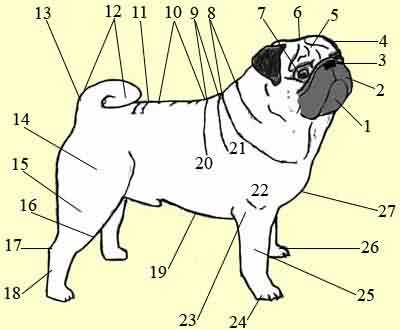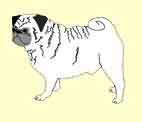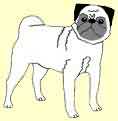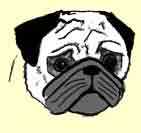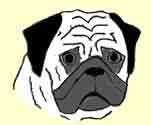
FCI-Standard N° 253 / 01.07.2009 / GB
ORIGIN : China. PATRONAGE : Great Britain.
1. GENERAL APPEARANCE |
10. LIMBS. FOREQUARTERS 11. HINDQUARTERS 12. FEET 13. TAIL 14. COAT. HAIR 15. COLOUR 16. WRINKLES, SKIN 17. GAIT / MOVEMENT 18. WEIGHT 19. Conclusion 20. FAULTS |
DATE OF PUBLICATION OF THE ORIGINAL VALID STANDARD : 26.03.2009.
UTILIZATION : Companion.
CLASSIFICATION F.C.I.: Group 9. Companion and Toy Dogs. Section 11.
Small Molossian type Dogs. Without working trial.
GENERAL APPEARANCE: Decidedly square and cobby, it is "multum in parvo" shown in compactness of form, well knit proportions and hardness of muscle.
BEHAVIOUR / TEMPERAMENT: Great charm, dignity and intelligence. Even-tempered, happy and lively disposition.
HEAD: Large, round, not apple-headed.
CRANIAL REGION: Skull: With no indentation. Wrinkles clearly defined.
FACIAL REGION:
Nose : Well opened nostrils.
Muzzle: Short, blunt, square, not upfaced.
Jaws/Teeth: Slightly undershot. Wry mouth, teeth or tongue showing all highly undesirable. Wide lower jaw with incisors almost in a straight line.
Eyes : Dark, very large, globular in shape, soft and solicitous in expression, very lustrous, and when excited, full of fire.
Ears: Thin, small, soft like black velvet. Two kinds - "Rose ear" -small drop ear which folds over and back to reveal the burr. "Button ear" - ear flap folding forward, tip lying close to skull to cover orifice, and pointing toward eye. Preference given to latter.
NECK: Slightly arched to resemble a crest, strong, thick with enough length to carry head proudly.
BODY: Short and cobby.
Back : Topline level, neither roached nor dipping.
Chest : Wide in chest and well ribbed.
TAIL (Twist) : High set, curled as tightly as possible over hip. Double curl highly desirable.
LIMBS. FOREQUARTERS: Legs very strong, straight, of moderate length, and well under body.
Shoulders: Well sloped.
HINDQUARTERS: Legs very strong, of moderate length, well under body, straight and parallel when viewed from rear.
Stifles: With good turn of stifles.
FEET: Neither so long as the foot of the hare, nor so round as that of the cat; well split toes; the nails black.
GAIT / MOVEMENT: Viewed from in front should rise and fall with legs well under shoulder, feet keeping directly to front, not turning in or out. From behind action just as true. Using forelegs strongly putting them well forward with hindlegs moving freely and using stifles well. A slight roll of hindquarters typifies gait.
COAT. HAIR: Fine, smooth, soft, short and glossy, neither harsh nor woolly.
COLOUR: Silver, apricot, fawn or black. Each clearly defined, to make contrast complete between colour, trace (black line extending from occiput to twist) and mask. Markings clearly defined. Muzzle or mask, ears, moles on cheeks, thumb mark or diamond on forehead and trace as black as possible.
WEIGHT: Ideal weight 6.3 - 8.1 kgs (14 - 18 lbs).
FAULTS : Any departure from the foregoing points should be considered a fault and the seriousness with which the fault should be regarded should be in exact proportion to its degree and its effect upon the health and welfare of the dog.
Any dog clearly showing physical or behavioural abnormalities shall be disqualified.
N.B. : Male animals should have two apparently normal testicles fully descended into the scrotum.
Any living creature is beautiful in its way
And as it is known, the beauty will save the world.
THE COMMENTARIES TO THE STANDARD
It is just to say that any dog, which has all the characteristics mentioned in the Standard, is a really good pug with few possible drawbacks.
There must be nothing that arouses confusion or uncertainty in anyone who reads the Standard: a small dog, the build is square, stocky, with heavy massive skeleton, a big head in proportion to the general dag's size, with a tail in the form of a tight ringlet.
The description of a pug, determined by the Standard, clearly represents its type but does not reveal the true picture of the dog's points, that is why it would be useful to expand and underline some of the requirements.
|
1. The lower jaw 2. The muzzle 3. The nose 4. The ear 5. The forehead 6. The skull 7. The eye 8. The neck 9. The withers 10. The back 11. The waist 12. The croup 13. The tail 14. The thigh 15. The shank 16. The knee 17. The heel 18. The metatarsus |
19. The lower line |
THE GENERAL APPEARANCE. THE SYMMETRY.
In evaluation first of all the entire dog is considered in general: is this certain pug the true representative of the breed's type? Do all of its parts correspond to each other?
The pug is a well-balanced dog. The expression "Multum in parvo" - "much in little" is realized due to the stockiness, strong skeleton and well-developed muscular system. Having small size the pug should look solid and compact with large amount of muscle mass and strong muscular system but no way stout.
You should remember that a pug is a dwarf dog not too big but not too small, by its constitution resembling a small stocky horse - cobby.
Reading the clause "General appearance; in the Standard, you will not find an expressive description of one thing, which is not paid attention to - "the firmness of developed muscles". This characteristic is of high importance and should not be ignored as the right movements of a dog may be distorted if the dog is in the wrong condition. Both stout and thin dogs are not desirable.
There is an opinion that you can go for a walk with a pug or do it very little, but it is not true that a pug cannot bear long walks. A good muscle structure is achieved not with heavy feeding and especially not by a diet but by regular trainings and walks.
A walk by the roads at a measured and even pace is as vitally important as a free running. A walk by hard surfaces as sand, gravel, high grass, water or deep snow is good as for the body muscles as for the legs' ones, but it should not last longer than 30 minutes (in hot or very cold weather 10 minutes are enough), if the time of a quiet walk is equal 1-1.5 hours.
An American expert and a breeder with more than 50-years experience, Thomas Shirly, in his book "The New Pug" tells about the problems which American breeders face in preservation of a breed type:
“During many years the breeders try to obtain high-quality pugs. We came a long way and still we have to overcome many obstacles. But the main thing is to preserve the breed type.
Do you know the difference between the three types of pug - a terrier, a bulldog, and a Chinese Shar-Pei?
An elegant (light) terrier type of pug stands out among other types.
It has a pronouncedly long neck which turns to the straight front (plumb-set bladebones and front extremities). I am surprised to hear that the majority prefers this type, considering it to be the most attractive. It is sad that these dogs often become winners.
The bulldog type is characterized by super wide front and an attractive head which is set on slantwise bladebones. Sometimes you can see these dogs have tubby positioned front extremities or bound bladebones.
|
|
|
But the most unacceptable is the modern Shar-Pei type and we should not allow its spread. Because of some of these breeders striving for fame we see these ponderous pugs with swinging croup. It is not typical for the pug. People try to fatten up these dogs to hide their long back and distorted topline. Since pugs got from China to Holland and England and then to America they only had rolling of the bladebones not of the croup. We should stop those who try to convince our experts, beginning breeders and inexperienced owners, that the dog's croup should swing in motion. If we do not stop them in time, they will destroy the true breed type”
In the middle of the 90s in Russia there was a wide spread of such large, raw, short-legged, hoggish pugs of the Shar-Pei type. The fatter and rawer the dog was, the higher place it occupied. It was painful to hear that with appearing of this dog the breed started improving…
But the time put everything in its place.
THE CHARACTER. THE TEMPERAMENT.
Pugs are characterized by a lot of charm, dignity, intelligence, courage and inborn cheerfulness. They are easy to get on with, faithful, mischievous and always aim at being in the centre of attention. From time to time they can be rather jealous and suspicious. Pugs in pack are fearless. They are very good guards. They enjoy playing with kids.
There are some differences in temperament of dark and light species: the light ones are more quiet and faithful as a rule, while the dark ones are more suspicious and energetic.
Shyness, nervousness and aggression are serious drawbacks.
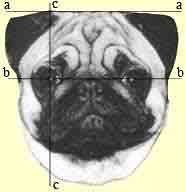 |
Pic.2 A well-balanced head. a-a. The top of the skull must be as flat as possible. It makes the same line with the ears. A dome-shaped skull is a serious drawback. |
The pug's head should not catch one's eye. It must be big enough, round, but not of the " apple"-form, without clearly marked bones. The top of the skull, seen from the front, should be almost flat between the ears; the eyes should be set widely enough, on the same level with the nose. The muzzle should be wide, deep enough (the height of the forehead is approximately equal to the depth of the muzzle) and flat. The lower jaw should be as wide as possible and the chin should be clearly marked; it is also important that the higher flews must be neat and refined, not heavy and not dangling.
The forehead is covered by deep, well-marked wrinkles. If we look from the side, the forehead must be flat. We can say from the side-view, the head of the pug should look like a clenched fist. A rounded forehead is a serious drawback.
The nostrils must be large (preferably of the same size as the eye of the dog), well-pigmented. A partially-pigmented nose ("the butterfly nose") is a drawback. A fully unpigmented nose ("the dudly nose") is a serious drawback. In little puppies, especially those born in the winter, the nostril sometimes gets pigmented only by 3-4 months. As a rule, such puppies also have weakly-pigmented ears.
The noses of modern pugs are very flat. One should remember that the length of the dorsum of nose must be a minimum of 10 mm. A slight extension of the nose's bridge is possible. The absence of the nose's bridge is a serious drawback. The wrinkle above the nose will be more delighting if it is continuous, but it will not be a drawback if it is "broken". A raw wrinkle hanging above the nose, which prevents the dog from normal breathing, is a bad defect.
Pic. 3. The heads
|
Pic.3a. The nostril is on the central line of the eyes. It is very important as the location of the nostril plays an important role in the muzzle's expression. If the point of the nostril is on the lower line of the eyes, the expression becomes gloomy. Pic.3b. The wrinkles on the muzzle of the given species aim at hiding the narrow skull and lack of fullness of the cheeks. |
You should remember: a pug is not only the head! It should be massive but it should not break the proportions of the whole dog.
The head of a male dog is bigger than a female's, and it is possible to determine the sex by the expression of the muzzle. Looking into the dog's "face" you should have no doubt about who is in front of you, a male or a female.
The muzzle should be as short and flat as possible, wide almost equal to the width of the forehead, set in front of the skull. It should be in harmony with the rest of the head. The lower jaw is as wide as possible, has a well-marked chin.
A pug with a weakly marked or narrow lower jaw will have badly filled muzzle under the eyes and there will be no typical pug's expression,which is a serious drawback .(Pic. 3a,b)
The eyes are dark, very large, slightly bulging, round, with tender and careful expression, very bright and in excitement are full of light.
The eyes have big importance and the standard does not mention that these large, dark eyes should be set quite widely. The line coming from the middle of an eye (pic. 2) should come through the higher line of the nostril.
If a pug has a narrow and weak lower jaw, most likely the eyes will be of small size, very closely set. The typical watchful and mischievous expression will be lost.
 normal |
 the white is slightly seen |
 bulging |
|
closely set |
slanting |
too small |
There are many dogs with light small eyes but this is a drawback: the eyes should be as dark as possible with pigmented eyelids and the white should not be.
Serious drawbacks: squint, the eyes with the seen white, slanting eyes, too small eyes.
The defects: exophthalmoses (telescope fish).
Why is exophthalmoses considered a defect? First, such eyes as slanting eyes are not natural for any breed and the create disharmony in the dog's appearance and exoph-thalmoses causes change in the relation of axes of the inner structure of an eye which in the end leads to brain changes. Second, it is more difficult for the restless, scurrying about pugs to protect such eyes from traumas, especially for puppies. And the traumas of eyes even if they are well-cured in 70 % lead to pigmental (colored) keratitis, i.e. the blood vessels come through the eyeball that leads to blindness. Due to these reasons the species which transmit exophthalmoses should not be used in breeding.
 "Buttons" |
 "Roses" |
 Different size of the ears |
 Too short. |
 Too long. |
 The false rose (open auricle). |
Pic. 4 The ears. |
|||||
The ears are small, soft as black velvet. There are two types of ears:
"rose-like" и "button-like". The second is more preferable.
That is all the Standard mentions about
the ears.
The pug's ears are moving when the dog is excited(makes "a diadem"), they should
be directed straight ahead.
The button-type ears break at the line of the skull and are directed straight ahead. The rose-type ears break at the back side of the ear. The button ear makes an impression of wider skull while the rose ear makes it narrower. A true rose ear can be easily mixed up with "flying ears" - "a false rose" (when the inner side of the auricle is seen). Light ears, which puppies have, should get darker with age.
For a male dog the long ears are better deviation then short and for female vice versa.
The drawbacks: light, too thick, too long, too small, highly or low set on the skull,
"the false rose", different size of ears. (Pic. 4)
It is necessary to check the mouth of the dog. The normal bite of the pug is a close
one and as the lower jaw should be wide (approximately as wide as the skull), the teeth
should be in a line (six cutting teeth). The possible pug's bite is not more than 3 mm
(Pic. 5 The bites). The serious drawbacks are the cases when the bite has such a big space so that the teeth
are seen or placed in the form of a boat what often makes a dog to show the tongue.
There are cases when the lower jaw is distorted and the tongue is seen on the side. The
scissor bite is seldom but it is a very serious drawback. Overshot bite is considered to
be a disqualifying defect. A modified facial side of the skull and accordingly the lower
jaw often lead to the improper location of the teeth ("staggered", lack of teeth and so
on), these are also drawbacks (Pic. 6.1, 6.2). Fallen out or broken cutting teeth (for an exterior exhibition) is not considered a
drawback if it does not prevent from determining the bite. Special attention should be paid to the question of lack of teeth, which is getting
more acute lately. A pug should have 6 cutting teeth and 2 fangs both on the lower and
the upper jaws. And though at the exterior exhibitions the lack of one or two teeth is
not considered a drawback, the fallen out teeth should not be mixed up with teeth
which have not grown at all. If a puppy has not a cutting tooth (or several), the Breeder should inform the Buyer
about it as the dog will lack those cutting teeth during second dentition. It happens so
that all primary teeth are present but during second dentition one or two cutting teeth
may be absent. The lack of teeth is inherited, that is why such dogs must be carefully
used in breeding.Anyway these dogs should be mated with the species whose ancestors in three generations
did not have problems with the dental formula. Only in this case the further
spread of lack of teeth. Unfortunately, the female pugs usually lose teeth after every whelping. The male
pugs lose teeth after 5-6 years old. This is connected with periodontosis, from which
pugs and smaller breeds suffer. That is why the experts at exterior exhibitions are
always interested in the age of the dogs exhibited. For adult dogs an expert determines
the type of the bite but if a young dog misses one cutting tooth he cannot confer a title
and can lower the assessment. At exhibitions there are often problems with examination of the mouth. The lower
lip of many pugs is very fleshy, adjoins tightly the lower teeth and can fully cover
them. It is very difficult to separate it from the teeth. That is why many experts examine
the teeth by touch or by raising the upper lip and lowering the lower lip from the
side. Many experts (very often the breed specialists) examine the dental system to
check if there is an overshot or scissors (lack of chin), distortion of the jaw (the tongue
is seen from the side, the symmetry of the muzzle is distorted), an undershot (the teeth
and the tongue are seen from the front) and so on. But if an expert examines the lower jaw and counts the teeth, this may be his hobby. The neck and the body should be connected by a strong neck, which has enough
length to bear the head in a proud manner. Immediately after the back side of the skull,
there must be slight eminence (the nape), which adds to the effect of the proudly set
head. The length of the neck is an important factor for achieving the harmonious transition
to the shoulders and so achieving a good impression of the dog's appearance. The drawbacks: the neck is too short -the head is visually set on shoulders; too long
- it gives a pug a clumsy look, the so-called "sheep's neck" (Bedlington Terrier). The body is square, stocky, with short back, wide in chest and has well-developed
ribs. The legs should be very strong, of moderate length and well-set under the dog.
The topline is very important. It should be even from the nape to the croup, the tail
should be set high. A pug should not be fat. It must have so much of muscle bulk to look thick; strong,
but not fat. The chest is rather large. The ribs are almost round, springy. The lower part
of the chest (the depth) is placed not higher the elbow level (Pic.7, the lower point of
the chest in the correct build is placed between the front legs). The lower line rises
gradually to the back legs, pulling up a little. Pic. 7. AA1=BB1- The skew length from the
humeroscapular joint to ischial tuberosity is equal to the height in withers. B1B2=1/2BB1- The length of the leg till the
elbow joint is equal to the half of the height in
withers; the line that C- The lowest point of the chest. (It is locat-
ed between the legs.) DD1- The vertical line which can be drawn
from the most prominent part of the thigh in case
of the correct position of the hind extremities
must cross the middle or the inner side of the metatarsus. The chest is wide but not as the bulldog's - this is a drawback. "The chicken chest"
is an abnormal development of the chest bones - it is a serious defect. If the stomach is
too much tucked - it is a drawback. The dog should have a little waist line. The male
dog has a thinner waist than a female but the impression of roundness should not be
impaired. The drawbacks: narrow-chested build (flat sides, deep but not wide enough chest),
which leads to insufficient springing of ribs; bow-shaped back, which creates appearance of a hunchback; a hollow behind the shoulders which is considered as a soft back;
low front; high front; extended shape (either due to the long chest or to the long waist).
(Pic. 8). The standard of this part of the body is clear enough. But we would like to specify
this point with several details: strong and straight legs must be set far enough from each
other (indicating a wide chest). Meanwhile, the shoulders should be sloping. We should add that the legs should be of moderate length. Stocky does not mean
short-legged. This feature can be expressed by the English word "cobby" (a small horse
similar to pony) or by Russian "Boletus mushroom". The standard admits that a grown-up pug has a well-developed muscular system at
the outer side of the legs, which forms an even, smooth arch. This also creates a false
impression of crooked legs. Such structure of legs is not a drawback. If you look at the
inner side of the dog's legs they will be absolutely straight. The front extremities should stand well under the dog and make a straight line from
the withers through the elbow to the ground. This can be seen if we examine the dog
from the side (Pic. 7). Pic. 9. Set of metacarpus. a. Correct b. Vertical c. Hollow d. Knuckling-over (the
joint is anteverted) The elbows should adjoin the body and be directed straight backwards, they should
not be turned neither inside nor outside, neither at the point nor in motion. Metacarpus should be lop-sided, not vertical. With vertical metacarpus, the pug will
clatter with bones during walk (Pic. 9b). Lop-sided metacarpus should not be mixed up with broken (hollow). Broken or
hollow metacarpus cannot support the dog's body (there will be a hole between the bladebones). The drawbacks: curved forearm, toes-out, hollow metacarpus, thin bones, weak
joints, narrow set of extremities, excessively short or long legs. Disqualifying defect: knuckling-over extremities.(Pic. 9d) Special attention should be paid to the angle of humeroscapular articulation! Stocky pugs with short backs often have moderate inclination of the bladebones or
too short humeral bones or both that makes nice-looking but wrong profile of a dog.
The main drawback (which is nowadays typical for pugs) is the angle of the
bladebone's inclination more than 45° and short humerus, it is the so-called terrier type
(Pic.11 - III, IV). As it is seen from the pictures, as far as the angle of humeroscapular joint changes
the lowest point of the chest shifts backwards behind the front extremities which tend to
get closer to each other as they do not need to embrace a wide chest and also the step's
length changes (shortens) (the festinating gait in case II and "drum-beat" in case III).
But the most unpleasant thing is that nowadays there are dogs with short humerus and
short and slightly inclined bladebone (Pic. 11 - IV). Such dogs can walk putting legs forward only at a very low speed (with very short step). At higher speed such pug could
move fast but the front legs would make a semicircle or would move from side to side
like a pendulum. This is a very serious drawback. Such animals should not be used for
breeding. Commentaries to picture 11. Types of humeroscapular articulation: A pug has big, full, muscular thighs, well-marked knee-joints and hocks. The
hindquarters should be in balance with the heavy head and must not seem higher than
the shoulders. The croup is stout and slightly rounded. The standard supposes that when the pug is
standing the hind legs should be well-set and parallel to each other (Pic.14). The pelvis should have inclination 30° to the horizon forming the right angle with
the thigh in thigh joint. The thigh and the shank must have moderate length, be equal to
each other, have low-set hocks, which means that the metatarsus should be short. In
case of right angles, such proportions will set the hind legs well under the dog and will
ensure correct topline. If the metatarsi are too long and the shanks are too short the angles will be incorrect and consequently the gait will be improper. The long metatarsi
or long shanks or both will lead to the high rear. It looks ugly and it is a serious drawback (Pic. 15). If a dog has good "front" and a good back but a flattened thigh, the dog's step will
be broken and you will see a jumping and swaying from side-to-side gait. You should
differentiate it from the typical pug's waddling gait. If a pug has a short shank but a long metatarsus, its heels start to hit each other dur-
ing movement, what is not typical for the correct pug's gait. The drawbacks: flat angles of heels and hocks. Serious drawbacks: thin bones, closely set heels, everted metatarsus, barrel-hocked legs. THE FEET OF THE FRONT AND HIND EXTREEMITIES The foot should be round, small but strong with thick pads, two middle digits
are slightly longer than the others. The toe should not be turned neither out nor inwards
(club-foot). The feet should look nice, the digits are slightly bent, the dog should stand
firmly on its legs (Pic.16). The drawbacks are squashed feet with thin pads, toes-out, light claws.
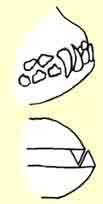
a - a close bite (the norm) 
b - a straight bite (pincers) 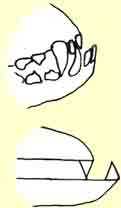
c - a bite with a space (a big
space is called an undershot)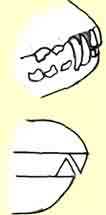
d - scissors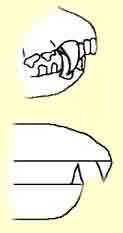
e - overshot bite.

A line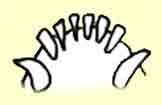
In the form of a boat
Staggered teeth

The regular bite (a close bite)
Horizontal shift of jaws
Vertical shift of jaws
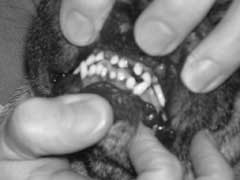
Wrong show bite.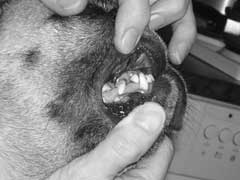
Proper showing of the bite (opening
teeth at the side, so the nose is not blocked).
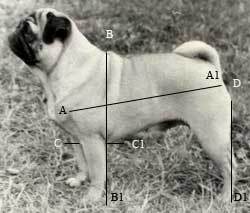
Pic. 8. Body
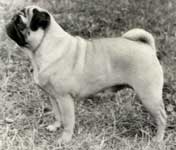
a - Correct body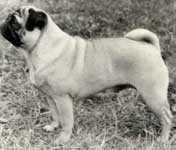
b - Soft hollow back with impression of high hind part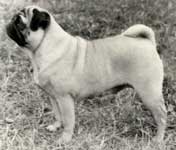
c - High hind part
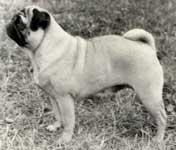
d - Bow-shaped back (hunchback)
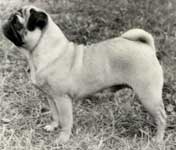
e - High hind part
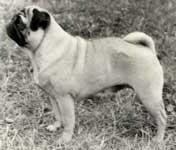
f - Skew croup and low-set tail

I. Correct profile
1.Correct humeroscapular articulation (ABC1=45°, ABC=90°, AC=BC). The legs are well set under the dog. We can mark perfect forearm's length and prominent chest line (E).
2. The neck graciously changes into the topline. It has
sufficient length to hold the head in a proud way, is slightly
arched as it is noted in the Standard, the withers are well
marked (D).
3.Well marked heel forms a nice curve F and sets the legs well under the body. The
correct angle of the articulation of the hind extremities (line H) form wide muscular
thighs (G- the width of the thigh).
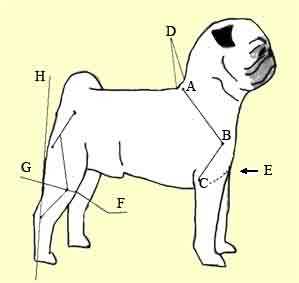
II.Incorrect profile
1. A pug with a short straight shoulder (ABC is more than 90°) carries its head too
high. It has good forearm's length but incorrect angle of articulation of the bladebone
(AB) and the shoulder (BC) what causes not enough prominent chest (E).
2. The neck is connected with the body abruptly, the withers are feebly marked (D).
3.Flattened heels (F) form not enough wide thighs (G). To hide this drawback han-
dlers often put the hind legs backwards to imitate angles and an elegant topline (H).
Such construction does not allow the legs to stand well under the dog as it is prescribed
by the Standard.
Pic. 13 Two compact, clearly typical pugs, view "three
quarters"
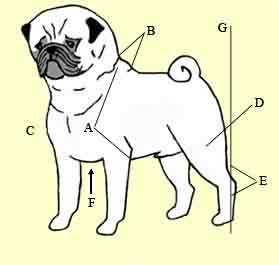
I.Correct
1. The shoulders lie correctly, the angle 45°. (A)
2. The neck graciously changes into the topline (B).
3. The correct bladebones can be determined by the
lines of these angles (C).
4. The width of the thighs (line D) shows the correctness of the hind angles.
5. The chest looks prominent due to the arch (E), show-
ing well rounded, springy ribs.
6. The more correct angles of the back extremities are, the better the hind legs are set
under the dog (G).
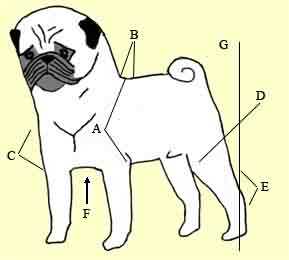
II. Incorrect
1. Very straight shoulder does not allow the front legs to stay well under the dog (A).
2. The neck with such angles changes sharply into the body (B).
3. At this perspective even a dog with well-developed chest would have a straight line due to the straight shoulders (C).
4. Thin thighs (width by line D is meant) together with
feebly marked heels (incorrect articulation angle) and with
feebly marked or absent hocks.
5. Straight shoulder often is accompanied by straight chest line between legs (E).




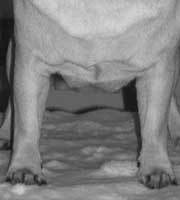
Correct set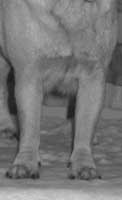
Narrow set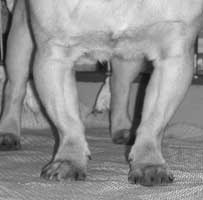
Curvature of forearms (barrel)
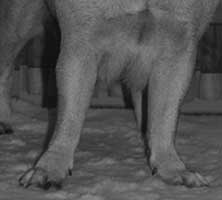
Toes-out (feet are turned outwards)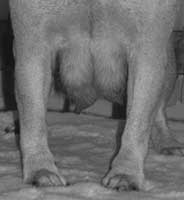
Club-foot (feet are
turned inwards)
Ideally the bladebone's inclination should be 45° to the horizon, forming right angle
(90°) with humeral bone. The length of the bladebone and the humerus should be equal. At examination the chestbone at the front and at the side should have very good
prominence (Pic. 11). Only such proportions can ensure wide, free, rolling movements
of front extremities.
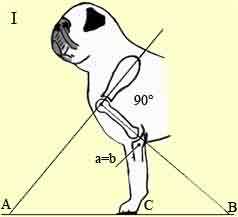
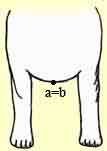
I a
The bladebone is inclined 45 ° to the horizon. The angle between the bladebone and the
shoulder is 90°. The bladebone's length is equal to the humerus's length. Such build has
widely and well set legs, makes good and prominent line of chest, the lowest chest's
point is located exactly between the front legs (Ia). At the pic. I it is clearly seen that
such articulation allows good and free leg's swing forward (rolling walk) and good and
long swing backwards (AC~CB), what makes the movements strong and energetic.
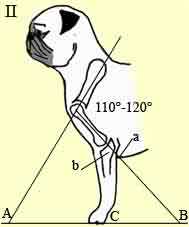
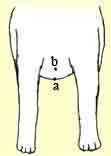
II a - III a
The bladebone is inclined more than 50° to the horizon, the angle between the
bladebone and the shoulder is more than 110°, the humerus's length is equal to the
bladebone's length (Pic. II).
With such build the front extremities are set slightly forward (Pic. II) and closer to each
other (Pic. IIa), than in the first case, the lowest chest's point is shifted behind the legs
(Pic. IIa), the chest line is less prominent. The step's length is shorter which makes the
gait festinating (AC~CB).
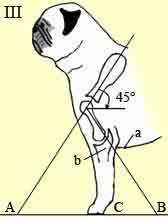
The bladebone is inclined 45° to the horizon but the humeral bone is shorter that the
bladebone and the angle between them is more than 90°.
Such build puts the front legs even more forward than in case II. The set of legs is nar-
row. The length of step forward (AC) is much more than backwards (CB). It seems as if
the dog throws the legs forward ("drum-beat"), and the more the bladebone is inclined
and the shorter the humerus is (or both), the more is the throwing the leg forward and
the shorter the step backwards.
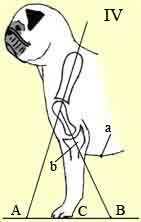
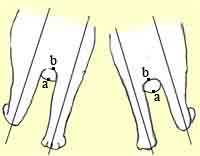
IV a
The bladebone is inclined more than 50° to the horizon. The articulation's angle is more
than 120°. The front extremities are practically on the same level with the most promi-
nent chest's point (chest line is not prominent), the lowest chest's point is shifted much
16
backwards, the legs are very close to each other. With such build the length of step for-
ward and backward is too short to ensure correct movements. That is why an animal
with such humeroscapular articulation, though they have
B correct angles of back extremities, start to swing with
F
their front legs right and left as a pendulum (IV), or make
a semicircle with them, to make the step's length of front
legs equal to the step's length of the hind ones.
![]()
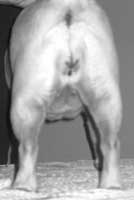
a) Correct angles. The step's
length is sufficient for a strong push
and therefore for correct move-
ments;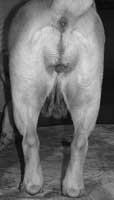
b) Straight angles. The step's
length is short, what leads to festi-
nating gait;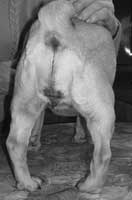
Бочкообразный

Сближеный
(коровий)
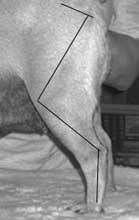
a) Correct angles. The step's
length is sufficient for a strong push
and therefore for correct move-
ments;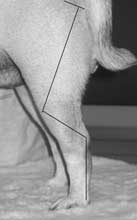
b) Straight angles. The step's
length is short, what leads to festinating gait;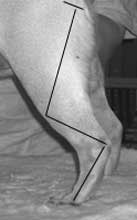
c) Saber-likeness, the metatarsi
are not vertically set, which often
happen in case of skew croup.

a) Regular (oval, arched, rolled
up);
b) "Feline"(round, arched,
rolled up)
c) "Hare-like"(hare-like, oval,
with long digits);
d) Spread
We should note that toes-out, hollow metacarpuses, curved digits are often the result of long (uncut) claws - it should be attended to.
The description of the tail in the Standard cannot be surpassed. The tail is neat, graceful, and full. The hair on it is a little longer than on the body. Double curl is magnificent, but one curl is not a drawback (Pic. 17).
Pic. 17 Tail's forms |
||||
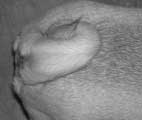 a) Regular (tightly curled, firmly pressed, high-set) - "shell" |
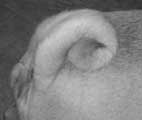 b) Tightly curled, firmly pressed but low-set; |
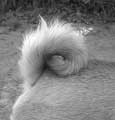 c) "Snail"-type tail (tightly curled, vertically set) |
||
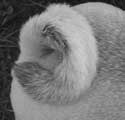 d) High-set, firmly pressed to the back, not enough curl; |
 e) Uncurled tail. |
 f) A shot tail. |
||
Drawbacks: weak curl or too short tail, which cannot form even one curl; the tail placed at the centre, "snail”, instead of lying, pressed to the hip, - it is a drawback, though many experts do not pay attention to this; the low-set tail and uncurled are also undesirable.
The coat is thin, smooth, short, and glossy, but it should by no means be harsh, fluffy or long. Standard prescribes only this. But pugs have a double coat. The lower, undercoat, is soft and thick, and the topcoat is thin, smooth, short and glossy. It is desir- able.
There are dogs with too much undercoat. Such pug looks "plump" (the hair is not pressed to the body but bristle), which is a drawback.
Many pugs nowadays have long and harsh coat. This is a serious drawback and it should be paid attention to. Of dogs with a long coat, 80% have drawbacks in their anatomical structure, their muscles are lax, and it does not have sufficient strength -- which says "much in a little" about a pug.
Black pugs have harsher coat than light ones and some dogs do not have undercoat. Black dogs have less hair bulbs per 1sq cm of skin than light ones and their skin is blue.
As for the pug's color the Standard is clear and certain but nevertheless many peo- ple interpret it wrongly.
&"Fawn", the pug's color designated in our pedigrees, can be paraphrased as beige,
pale-yellow or sandy but it is not quite correct. There is nothing harder than describing
the light color.
The word "fawn" means the color of a young deer but there are no pugs of such
color. What is "fawn" for a pug is "yellow" for a Labrador and "gold" for a Golden
Retriever.
The second, rarer, meaning of the word "fawn" is yellow-brown. It is closer to the pug's color and originally the breed's color in pedigrees. "Rus'" and "Elite" of the Podolsk association of dog-breeders was designated as yellow-brown.
So "fawn" is a warm, yellow-brown of different tints.
"Apricot" of a pug has nothing to do with "apricot" of a poodle. It means yellow of any depth, with warm, orange hue.
"Silver fawn" means silver-yellow-brown, it should not be dirty. It should be clear, cold-yellow, it should have the same difference with "fawn" and "apricot" as moonlight is different from sunlight.
Black color is glossy, blue-black, jet-black, like crow's wing, without addition of red or white hair or their specks throughout the coat. Dingy hair, red or yellow colors on the coat are serious drawbacks.
There are too many black pugs nowadays that have bad color. The reason of it is the mixing of two colors, it is a serious drawback but it does not mean that it is forbidden to mate yellow dogs with black. The black ones which have only the gene of black color (homozygous) are rarely found. Most pugs of black color (90%) have genes of both black and yellow colors (heterozygous). That is why even black pugs can have yellow puppies which can have no gene of black color at all; or the puppies can be black, but when they grow up they become brown. The breeders who have black pugs or those who what to get black puppies must be ready to get black puppies with brown tint. Such puppies should be sold as dogs of "pet"- class, it means as companion-dogs. Try to avoid zonary coloring. Light dogs should be free from black and dirt. Darkening (dirt) usually can be seen on the forehead, legs, chest, across the back or can be found as a wide saddle-like marking which makes the coat look dirty. It is a very serious drawback.
Very often zonary coloring is considered as silver. It is radically false. Real silver color as well as apricot, are very rare (though every second puppy of our breeders' is called "apricot")!
As for the markings (mask, moles, "diamond", eye contours, ears) together with wrinkles, they create a unique gallery of pugs' "faces" of light pugs. Black pugs do not have markings, but their faces are not less expressive.
The mask should be black and clearly outlined. The deeper the color is, the better. The depth and the width of the mask can differ in each individual case. Outlining the eyes and eyebrows, the mask should cover the upper and the lower jaws. The mask together with the moles and the diamond makes complete picture of the head and cre- ates the impression of the dog's head in general.
The expert can disqualify a dog for its color.
The "diamond" on the forehead is very desirable, but absence of it is not considered to be a serious drawback. Darkened head is not desirable. The "belt" is a dark line which starts at the head and goes to the tail. Researches made for a number of years showed that the "belt" is only tinting (the hair's end is darker the its stem). Light pugs almost never have a black "belt". It is usually brown, it means darker than the basic color. A wide black saddle-like stripe on the back is very undesir- able. It spoils the dog's general appearance, creates a dirty impression.
Occasionally a light pug with black fluff (undercoat) on the back can be found. Remember that it should not take place, it is a serious drawback.
In pursuit of light color very often diamond on the forehead is lost, the "belt" on the back, the mask, the ears, moles disappear, the claws get lighter. It is very alarming. Many pugs have light claws and it is not clear why experts do not pay attention to this. The standard says very precisely about this - the claws should be black.
Other important characteristics of a pug are his wrinkles and loose skin. Wrinkles on the muzzle are obligatory, they should be big and deep, and make the "face" well-shaped.
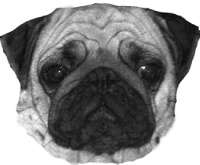 Pic. Very pure-bred head of a female dog. |
It is often said about the pug that he "speaks" with his brows. It is moving brows that make different expressions of the pug's face. Too large head or excessive number of raw wrinkles are undesirable. Harmonious pug's "face" is of a square shape with a nose in the centre. Excessive skin under the throat forms big suspension. There are wrinkles around the neck and there should be free skin, which forms deep thick rolls on the neck of adult pugs. Tiny wrinkles can appear on the wrists. As it was mentioned above a pug should have much of free skin. But! A pug should not have wrinkles, hanging skin or deep rolls on the body. Rawness is a very serious drawback. |
Some people think that pug's gait is impossible to define. But all breed's traits show us how the pug should move. If a pug conforms to the breed's type it should move only in a definite way. Pug's free walk leaves prints shifted a little to the body's axis (Pic.18).
Pic.18 Correct movements |
||
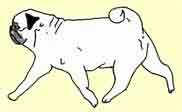 From the side |
 From the front |
 From behind |
When a pug goes away from you the hocks should be parallel to each other, legs are neither barrel-hocked nor cow-hocked. In this case you see only hind legs. It must approach you without turning legs neither inwards nor outwards (Pic. 18). You see only front legs.
Pic. 19 Incorrect movements of the front and hind legs |
||
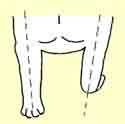 Too wide |
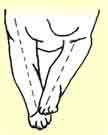 Overshoot (restrained walk) |
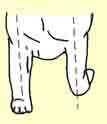 Swipping |
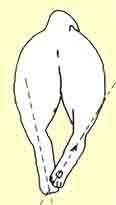 Overshooting |
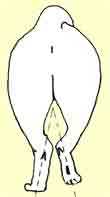 Close (Cow-hocked) |
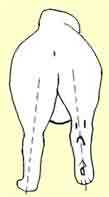 Too wide |
The pug's gait should be springy, free and elegant. It seems that a pug is rolling over when he is walking, but it is difficult to say whether it is caused by the movements of the hind or front legs. When moving the pug's body is supported simultaneously by the two legs, which are moving forward, replacing each other by diagonal pairs (Pic. 18). A pug is balancing around the center of gravity, in other words, it is swaying from one side to the other, what can be called "a drunk boatswain's gait". The balance is achieved by shifting the feet inwards to the body's axis.
If we look from the side, the pug should move its front legs sweepingly, putting them well, directed ahead, and pushing strongly by the hind legs.
Bulldog and Pekinese, whose front part of the body is wider than the hindquarter,
tend to twist with their hind part and the footprints of the hind legs are placed inside the
footprints of the front legs. But pugs move differently.
How does the pug "waddle"? This waddling depends on the length of its front legs' steps. When the pug puts its front leg too ahead, the shoulder goes down for a moment and the effect of waddling appears. The easy, rolling walk of the pug has its own name: "Mops Roll". But unfortunately nowadays there are more dogs on the rings with defect- ed movements then with correct movements.
In the book “Dog's Movements”, author Rachel Page Elliott writes - "The dog's movements speak clearly about its build as the movements reflect the dog's physi- cal coordination and body proportions. The health and the length of the dog's life depend on the correct movement."
The necessary condition for correct movements is the correct angles of the front and hind legs. The right angles and proportionality of the bones' lengths add to the free- dom and the correct rhythm of movements (and to the good rolling walk). The bones should bend and unbend easily, ensuring a strong push of the hind legs and springiness of the forequarters for the amortization of the push, if the dog is supported by the front legs. It has the rolling gait or "Mop's Roll" only if the articulations' angles are correct- the dog moves easily, appearing to make no effort.
Now we will see in what way the drawbacks of anatomy are connected with the drawbacks of movements.
Straight angles of both front and hind legs can make the step shorter and the gait more festinating. It can be clearly seen if we look from the side. When looking from the front or from behind, the movements seem to be correct (Pic.20).
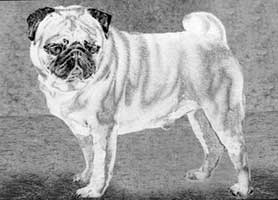 Pic. 20 The angles of front and hind legs of this dog leave much to be desired. The step with such angles is too short and the movements are festinating. |
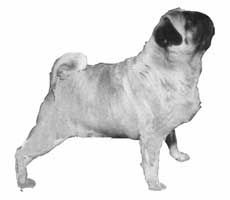 Pic. 21 Discrepancy of legs' length |
The dog at Pic.21 has relatively correct angles of the humeroscapular articulation, but too long thigh or shin, or thigh and shin both. With such anatomy, the step's length of hind legs is more than of front legs. If the dog moves as it is written in the Standard, raising the legs straight forward, then after one step or two the dog will tumble over the head. This is why it has to make a semicircle with its front legs to make the step of the front and hind legs equal. It can be clearly seen if the dog is approaching you.
Such anatomy and such movements can be inherited, that is why they are consid- ered defective. Such animals should not be use in breeding.
The movements of the dogs described above are similar to the movements of dogs with short humerus, short shoulder blade and quite correct angles of the hind legs, which were shown at Pic.11 1Y-1Ya.
The dog at Pic. 22 has good angles of front legs' articulation and short thigh and shin; in case of right back this will lead to straight angles of knee joints and hocks. With such anatomy, the length of front legs' step is more than hind legs' step. During movement it can be clearly seen that this species doesn't have enough push from the hind legs, the dog drags them after the front ones.
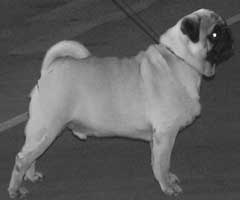 Pic. 22 Good front but the hind legs are too short |
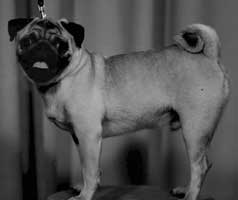 Pic.23 High rear (because of wrong angles of hind legs) |
Another possible variant (Pic.23) is when the thigh and shin are sufficiently long but the angles of articulations of knees and hocks are not enough, then you will see the topline which declines to the shoulders (High rear). With such anatomy, the length of the front and hind leg's step is almost equal. Such dog will be good in movement but not so good in pointing.
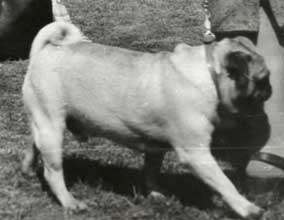 Pic.24 Ambling |
Ambling is considered to be defective gait, it means that two right legs and then two left legs are raised simultaneously. Such gait is typical for pugs whose owners are mov- ing slowly and hold their pet on a short lead. Sometimes in order to put the dog out of ambling it is enough to speed up your walk but sometimes this gait is firmly fixed (Pic.24).
The pug's weight according to the Standard should be from 6,5 to 8,5 kg. Theweight as a separate feature cannot determine the size of the dog. One should remember that among pygmy dogs the pug has the most mass density per 1 cm.The Standard implies that female and male dogs should be of the same size, but it is desirable that female dogs weigh approximately 7,5-9 kg (16.5-19.8 pounds) and male dogs 9-11 kg (19.8-24.25 pounds).
Desirable height is 26-28 cm (10 - 11 inches) in withers for female dogs and 29-31 cm (11.4 - 12 inches) for male dogs. Species of less than 25,5 cm high and higher than 32 are both undesirable. It should be taken into account while evaluating. One should also remember that if the height of a male dog is 25,5 cm, it should look like a male dog and the same about a female dog 30 cm high, the sexual type should be distinctly seen.
The criterion for evaluating weight and size should be the breed type.
A number of experts consider that the best male dogs are those which are bigger and have heavier build, though actually they are quite rough.
Another problem is the pursuit of many breeders to get as many small species as possible. The danger of such selection is that pugs become pitiful, miserable, and sex- less.
There are pugs which are so far from the Standard, but they cannot claim to get high mark regardless of their weight and size.
So the criterion for evaluating weight and size should be the happy medium -EVERYTHING SHOULD BE NORMAL AND NOTHING UNDUE.
So, what should be considered as a full universal characteristic of the pug's appear- ance, including its type, harmony, physical strength, character and good looks?
The American Standard evaluates the head of light species for 40 points out of 100, and of black ones - for 35 points. It means that the pug is a "large-headed dog". But even a most beautiful head is of no value if it is set on a wrong type of body.
One should remember the pug also has a body. The even topline, square body, firm and developed muscles, correct angles of leg's articulations - these features are insepa- rable. Without them the head, the neck, the tail or legs can lose the harmony. Don't pay much attention to one feature. A well-balanced dog is the one whose parts suit each other and are in harmony and there is no doubt that it should be in a differ- ent way.
A pug is a friendly dog, and courageous by nature. It can present itself in a good way and the owner's task is to develop this quality to a perfect level.
Please, pay attention to the movements. The pug should move as a pug (Mop's roll) and no other way. Only correct angles can ensure balance and harmony, create good bearing. The pug should move with a free lead and with free walk (not fast, not too slowly and surely not running).
Other important aspects are the color and the coat. One should remember that the color should be clear and the coat short and glossy. The dogs should not be "dirty" or have long hair. It's hard to prevent in breeding, so the breeders should select couples carefully, and the experts should take it into account while evaluating.
The weight is very important. Though the desirable weight is indicated in the Standard, it should correspond to the dog's size, its bones and muscle system.The pug is multo in parvo - much mass in little volume - so the mass plays an equal role with the size. The pug should not be thin, as when the dog lacks the necessary mass..The pug should not be fat either. It should have such amount of muscle mass to look impressive but not fat.The pug is pigmy, square, harmonious, with good mus- cles.Species with well-developed muscles weigh more than fat dogs.
The skin of the pug should be elastic it should cover the prominent muscles. It should not be hanging but not strained either. There should be neither fatness nor thin- ness.
Chicken breast is a very bad drawback. Not a single dog with this defect should be used in breeding.
We would like to remind you that even an insignificant drawback can influence the
dog's health:
- too bulging eyes are often traumas which can lead to blindness or loss of eyes;
- a short shoulder or shoulder-blade (the angle of humeroscapular articulation is
more than 100) can beat fingers to blood;
- narrow chest can cause oppressed lungs and heart;
- hunched back, strained loin - pain in the stomach, liver and heart, probably chron-
ic inflammation of the sciatic nerve;
- length disparity of front and hind legs, wrong angles of articulations can lead to
wrong movement and as a consequence the diseases of locomotor apparatus;
- shortened fingers (a sort of dismelia) are a genetic abnormality with all its conse-
quences.
It goes without saying there are no ideal dogs, but the breeder's aim is to prevent use of dogs having any drawbacks in breeding in order to obtain healthy progeny close to the Standard's requirements.
In assessment of "the best of the breed" the experts often prefer male dogs, as they look more impressive; though male and female dogs are equal in all aspects. This is fundamentally incorrect. The female dog is the basis of the breed! Do not overlook good female dogs!
In assessment of "the best of the breed" the experts often prefer male dogs, as they look more impressive; though male and female dogs are equal in all aspects. This is fundamentally incorrect. The female dog is the basis of the breed! Do not overlook good female dogs!
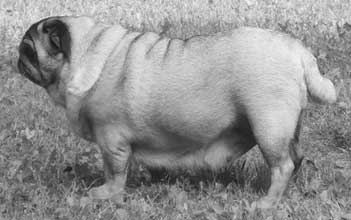
1. This dog is too heavy, the back is (hollow) weak, tail is loose, saber-likeness, skew croup, straight hocks, spread feet, inverted metacarpuses, too open angle of humeroscapular articulation, duck-type breast, "damp" coat. The dog hardly moves. As a rule, such species have bad shortness of breath, heart diseases, and diseases of loco- motor apparatus.
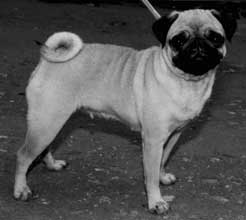
2. A very young species which is in the formation stage. It seems to be too turned up on her legs because the chest is much higher than the elbow. With age the chest will become wider and move down (look at the line) and the impression of long legs will disappear. This female dog has very beautiful head which is proportional to the body (the ears are slightly too long), she is compact enough, has good angles of front and back legs, but her tail is weakly curled. Later this dog will be more mature and well- shaped, she should not have joint diseases, she will move easily till she is old.
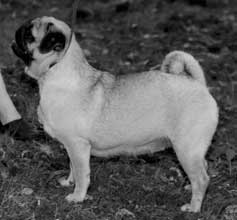
3. Not a bad young dog: the head is proportional to the body; the neck has good position and length. Sufficient angles of humeroscapular articulations and of hocks and knee joints as well. Chest is well developed. This species has too "soft" back (it is hol- low between the shoulder-blades), the loins are too strained and the tail is "snail"- type.
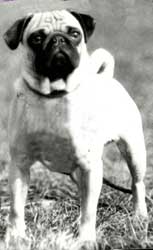
4. A young, male dog, his head is in the shaping stage. The muzzle is a little too long, it is deep enough but not wide enough. He has two different types of ears: one is "rose" type and the other is "button" type. This dog has a short shoulder (there is a typical "arch" between the front legs). The chest is wide and deep enough for this age. The dog is compact enough. The "snail" tail is clearly seen.
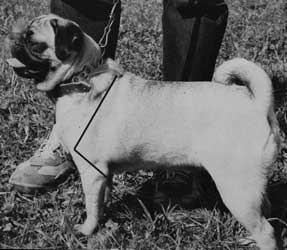
4. The photo of the previous male dog from the side. On this picture we can see that the muzzle is too long. The dog has a short shoulder (there is almost no protruding of chest), but it has good angles of knee joints and hocks. It is compact enough. The tail is curled as a snail and highly set.
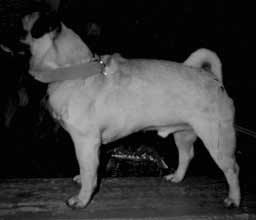
5. A pedigreed, slightly extended, physically strong young male dog. The shoulder is rather short. The angles of the hind legs should be more distinct. The body is extend- ed because of long loins. The croup is skew. The tail is low set and weakly curled.
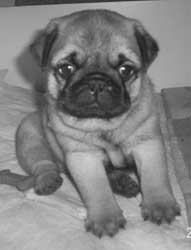
6.This puppy has a round head, the muzzle is deep and wide enough, but it is too low. The line lying at the top of the nostril does not come through the eyes' corners as it should be, but by the lower eyelid, which gives a funny, offended look. The puppy has developed locomotor system but the shoulder is not long enough. That is why the dis- tance between the front legs is too short and the legs are set forward too much, and it can cause wrong movements.
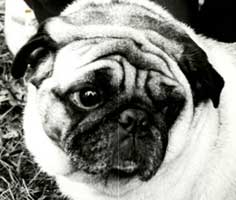
7.This picture is of the big, pedigreed head of a grown-up, male dog. The ears are of a "false rose" type, the auricle is seen. The muzzle is deep but not wide enough. Moreover the muzzle is low set, the nostrils are too low. That is why the space under the eyes is not "well-filled". The cheek bones are rather wide. The flews are "raw", they should not be lower than the lower jaw.
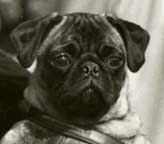
8.In this picture we can see the head of a young female dog. The ears are big and too long; a deep, but narrow, muzzle. The nasal arch is too long. But the main drawback that the muzzle is too dark.
Unfortunately, we did not manage to show the photo of feet with too short fingers (a sort of dismelia - it varies from lack of a phalanx on one finger to the absence of all legs). This is not a drawback or defect, it is GENETIC MALFORMATION. Using dogs with this defect in breeding is a CRIME AGAINST THE BREED.
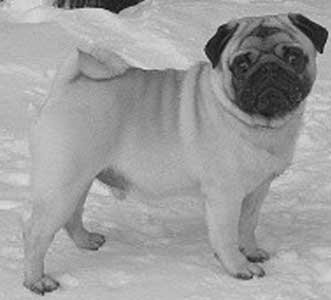
This is a very pedigreed young male dog. He has a perfect head, which is proportional to the body. The nostril is on the line, which comes through the corners of the eyes. This line divides the face equally to two halves. That is why the muzzle is deep (the muzzle's depth is equal to the height of the forehead) and wide. Even the "rose" ears do not spoil it. The body is compact; the topline is even. It is well seen that the tail is highly set and pressed tightly to the body, it is curled but only once. The chest is large, wide enough and deep. It would be desirable if the shoulder would be longer. The angles of knee joints and hocks are very good. In general, the dog is very pedigreed and good.
Dear pug-keepers!
There are no dogs (as well as people) without any drawbacks. The commentaries to the Standard are written rather for serious breeders who work with this breed profes- sionally. Before you mate a female dog with a male, we would like you to think with all seriousness. Consult with your conscience about how healthy and viable the progeny will be; and about how good it will be for the breed.
There is a saying: IF WE WOULD CONSTANTLY THINK OF GOOD THEN WE WILL NOT SPEAK ABOUT BAD, SO WE WILL NOT SPEAK ABOUT BAD THEN WE WILL DO ONLY GOOD! AS YOU THINK, SO YOU WILL SAY AND DO!
If we say it in terms of cynology: if you have thought well and taken everything into account, if you have chosen a good couple - you will get high-class progeny. But for owners of these charming creatures we would like to say: if you find some drawbacks in your pet - never mind! Anyway, your dog is the most beautiful, the most clever, the most faithful and the best of all because it is YOUR dog!

